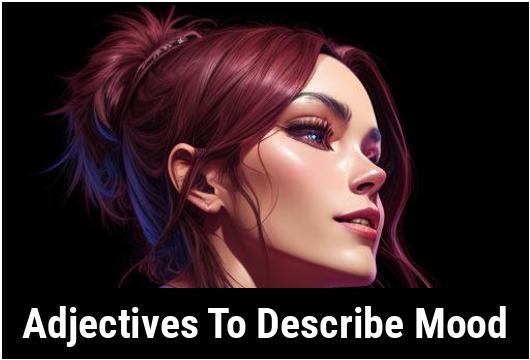- You are here:
- Home »
- adjectives
- » 41 Adjectives To Describe Mood

41 Adjectives To Describe Mood
In the realm of communication and expression, the use of adjectives plays a fundamental role in conveying emotions and setting the tone. Adjectives that describe mood have the power to capture the essence of feelings, emotions, and atmospheres, allowing us to more precisely articulate our inner states to others. Whether in writing, speaking, or nonverbal communication, employing the right adjectives can help better convey moods, making interactions richer and more nuanced.
Key Takeaways
- Adjectives are essential in describing mood as they establish the emotional ambiance of a situation or experience.
- Choosing the appropriate adjective can be nuanced and requires consideration of various factors such as intensity, context, and specific emotions.
- Understanding the different types of adjectives used for describing various moods can significantly enhance one’s ability to communicate effectively and empathetically.
Adjectives To Describe Mood
1. Blissful
When everything feels perfect and you are overwhelmed with happiness, you’re in a blissful mood. It’s that magical feeling like everything is aligned, and you are content with life’s current state.
2. Content
Contentment is a sense of peacefulness and satisfaction. You are happy with where you are, and there is a serene acceptance of the present moment.
3. Ecstatic
Ecstasy is an intensely joyful mood that makes you feel like you’re floating on cloud nine. It’s a euphoric state filled with excitement and delight.
4. Melancholic
When a wave of sadness washes over you, and you feel pensive or reflective, you’re in a melancholic mood. It’s a deep, soulful state where emotions run deep.
5. Elated
Elation is an overwhelming feeling of joy and pride. It’s like experiencing the highest level of happiness and feeling an immense sense of accomplishment or delight.
6. Serene
Serene is a mood of tranquility, peace, and calmness. It’s when you feel a deep sense of ease and inner quietude.
7. Inspired
Being inspired is a mood where you feel motivated, creative, and ready to take on the world. You feel energized and eager to bring new ideas to life.
8. Nostalgic
Nostalgia is a bittersweet sensation that arises when you recall fond memories from the past. It can evoke feelings of longing and sentimentality.
9. Anxious
When you’re in an anxious mood, you feel uneasy, apprehensive, and nervous. It’s a state where worries and stress may be overwhelming.
10. Jubilant
Jubilation is an exultant and triumphant mood. You’re jubilant when you feel immense joy, often accompanied by a desire to celebrate and share your happiness.
11. Reflective
The reflective mood is characterized by deep thoughtfulness and contemplation. It’s when you introspectively ponder on life, choices, and personal growth.
12. Grateful
A grateful mood occurs when you feel appreciative of the things and people in your life. It’s when you acknowledge the blessings around you and cultivate a sense of thankfulness.
13. Irritated
Feeling irritated is a mood characterized by annoyance, frustration, or impatience. It’s when small things bother you more than usual.
14. Serendipitous
A serendipitous mood is marked by pleasant surprises, chance encounters, and fortunate events. You feel lucky and grateful for unexpected blessings that come your way.
15. Determined
Determination is a resolute mood where you have a strong sense of purpose and focus. You are motivated to overcome obstacles and achieve your goals.
16. Optimistic
When you’re in an optimistic mood, you see the positives in every situation. You have hope for the future and believe that things will turn out well.
17. Frustrated
Frustration arises when you feel thwarted, dissatisfied, or blocked from achieving something. It’s a mood where challenges and obstacles test your patience.
18. Restless
Restlessness is a mood of unease and a longing for change, adventure, or new experiences. You may feel fidgety and long for something different.
19. Enthusiastic
Enthusiasm is an infectious mood full of zest, passion, and excitement. You are eager to engage in activities, share your energy, and inspire others.
20. Peaceful
Peaceful is a state of serenity and freedom from disturbances. It’s when you feel at ease, untroubled, and perfectly tranquil.
21. Annoyed
Annoyance is a slight feeling of irritation or disturbance. It’s when something or someone bothers you, but it doesn’t reach the level of full-on anger.
22. Hopeful
A hopeful mood is filled with optimism for the future. It’s when you have faith and confidence that things will improve or turn out positively.
23. Drained
Feeling drained means being exhausted physically, emotionally, or mentally. It’s a state of depletion where you lack energy or motivation.
24. Accomplished
Accomplishment is a mood of fulfillment and pride resulting from achieving goals or completing tasks. It’s when you feel a sense of triumph and success.
25. Bored
Boredom is a mood characterized by a lack of interest in your current activities or a feeling of monotony. You may seek stimuli or entertainment to escape this state.
26. Enraged
Being enraged refers to extreme anger and fury. It’s when you feel an intense, uncontrollable wrath that may cloud your judgment.
27. Curious
Curiosity is a mood of inquisitiveness and eagerness to learn. You are open to new experiences, asking questions, and exploring the unknown.
28. Grumpy
Feeling grumpy describes a mood where you’re irritable, grouchy, or easily annoyed. It’s when you seem less inclined to interact positively with others.
29. Relieved
Relief is a mood that surfaces after a stressful situation has resolved. You feel lighter, calm, and grateful that a burden has been lifted.
30. Contemplative
Being contemplative means you’re deeply immersed in thought and reflection. You ponder ideas, concepts, or life’s deeper meanings.
31. Empowered
Empowerment is a mood where you feel strong, capable, and in control of your life. You have confidence in your abilities to effect positive change.
32. Confused
A confusing mood is when you feel mixed up, uncertain, or unable to understand something clearly. It’s a state of mental puzzlement.
33. Excited
Excitement is a mood of anticipation, exhilaration, and enthusiasm. It’s a bubbling feeling of energy and eagerness for what lies ahead.
34. Overwhelmed
Overwhelm is a mood characterized by feeling completely submerged, swamped, or burdened by a multitude of emotions, tasks, or responsibilities.
35. Charismatic
A charismatic mood implies having a compelling charm, allure, and magnetism. You draw others towards you with your infectious energy and enthusiasm.
36. Disappointed
A disappointed mood emerges from unmet expectations or unsatisfactory outcomes. It’s when you feel let down, sad, or disheartened.
37. Satisfied
Satisfaction is a contented mood that arises when your desires or expectations are fulfilled. You’re pleased with the results or outcomes.
38. Worried
Feeling worried denotes a mood of anxiety, uneasiness, or concern. It’s when you dwell on potential negative outcomes or uncertainties.
39. Energetic
An energetic mood is characterized by high levels of vitality, enthusiasm, and vigor. You feel full of life and ready to take on challenges.
40. Playful
Being playful is a mood marked by lightheartedness, joy, and a desire for fun. You engage in activities that bring out your inner child and foster spontaneity.
41. Complacent
A complacent mood entails self-satisfaction and a lack of motivation to improve. It’s when you’re too content or satisfied with the status quo.
Why Use Adjectives To Describe Mood
Adjectives are an integral part of language that brings depth and nuance to our descriptions of mood. They play a crucial role in painting a vivid and evocative picture of an emotional state or atmosphere. When communicating thoughts and feelings to others, the use of adjectives can help create a more nuanced, accurate, and impactful portrayal of our emotions.
By using adjectives to describe mood, individuals can better convey the intensity, nuances, and subtleties of their emotional experiences. In both verbal and written communication, the apt use of descriptive adjectives can evoke empathy, understanding, and resonance in the listener or reader. This enhances the depth and clarity of the message being conveyed, fostering better communication and connection.
Additionally, adjectives that describe mood can also serve as powerful tools for self-expression and introspection. By carefully selecting the right adjectives to articulate their own emotions, individuals can develop a deeper understanding of their internal states, leading to enhanced self-awareness and emotional intelligence.
In literature, film, and other forms of art, the use of mood-descriptive adjectives is indispensable for creating immersive, evocative experiences. Authors, filmmakers, and artists rely on adjectives to set the emotional tone of their narratives, shaping the audience’s experience and eliciting specific emotional responses.
How To Choose The Right Adjective To Describe Mood
Selecting the most fitting adjective to describe a particular mood requires a thoughtful consideration of various factors. To effectively convey the desired emotional ambiance, one should take into account the intensity, nuance, and context of the mood being described.
-
Intensity of the Mood: Different moods can vary widely in intensity, ranging from subtle and fleeting to overpowering and profound. When choosing an adjective to describe a mood, it’s essential to consider the intensity of the emotion in order to accurately capture its impact on the individual or the environment.
-
Specificity of Emotion: Emotions encompass a wide spectrum, and the use of precise, specific adjectives can help convey a more detailed and evocative portrayal of the mood. For instance, rather than simply describing someone as "happy," using adjectives like "elated," "joyful," or "ecstatic" can more effectively capture the nuances of their emotional state.
-
Context and Environment: The context in which a mood is experienced greatly influences the choice of adjectives used to describe it. The same emotion might be described differently based on the surrounding environment, social dynamics, and individual perceptions. Adapting the choice of adjectives to reflect these contextual nuances is crucial in accurately portraying the mood.
Types Of Adjectives For Describing Mood
Adjectives used to describe mood can be classified into various categories based on the emotional states they convey. These adjectives capture a broad spectrum of moods, ranging from euphoric and tranquil to melancholic and anxious. Understanding the different types of mood-related adjectives can greatly enrich one’s descriptive and communicative capabilities.
Positive Moods
Positive moods encompass a range of emotions that evoke happiness, contentment, enthusiasm, and optimism. Using adjectives to describe positive moods can convey feelings of joy, fulfillment, and positivity.
Some examples of adjectives to describe positive moods include:
- Euphoric
- Radiant
- Blissful
- Jubilant
- Exuberant
- Vibrant
- Serene
- Ecstatic
- Buoyant
- Content
- Elated
Negative Moods
Negative moods encompass emotions that evoke sadness, frustration, anger, anxiety, and despair. Adjectives used to describe negative moods can convey feelings of distress, disillusionment, and pessimism.
Some examples of adjectives to describe negative moods include:
- Melancholic
- Despondent
- Agitated
- Disheartened
- Forlorn
- Anguished
- Dismal
- Gloomy
- Irritable
- Desperate
- Anxious
Neutral And Ambiguous Moods
Neutral and ambiguous moods encompass emotions that are neither distinctly positive nor negative. They may evoke a sense of introspection, contemplation, or uncertainty. Adjectives used to describe neutral and ambiguous moods can convey feelings of tranquility, curiosity, and contemplation.
Some examples of adjectives to describe neutral and ambiguous moods include:
- Pensive
- Reflective
- Ambivalent
- Wistful
- Enigmatic
- Subdued
- Somber
- Tentative
- Nostalgic
- Reserved
- Indifferent
Intense And Overpowering Moods
Intense and overpowering moods encompass emotions that are extremely potent, often dominating one’s thoughts and actions. These moods can be characterized by their profound impact on an individual’s mental and emotional state.
Some examples of adjectives to describe intense and overpowering moods include:
- Overwhelmed
- Consumed
- Obsessive
- Enraged
- Devastated
- Awestruck
- Spellbound
- Captivated
- Entranced
- Rapturous
- Paralyzed
Subtle And Subdued Moods
Subtle and subdued moods encompass emotions that are gentle, understated, and nuanced. These moods may evoke feelings of delicacy, restraint, and introspection.
Some examples of adjectives to describe subtle and subdued moods include:
- Mellow
- Hushed
- Serene
- Soothing
- Tranquil
- Placid
- Wistful
- Reserved
- Whispered
- Delicate
- Ethereal
In the realm of communication, adjectives are indispensable tools for describing mood with depth, precision, and nuance. By employing the right adjectives, individuals can more effectively convey the emotional ambiance of a situation or experience, enhancing both verbal and written communication. Understanding the nuances of different types of mood-related adjectives allows for a more comprehensive and evocative portrayal of emotions, facilitating empathy, connection, and self-awareness. Whether describing positive, negative, neutral, intense, or subtle moods, the adept use of adjectives enriches our ability to express, understand, and navigate the complex landscape of human emotions.
Examples Of Adjectives For Different Types Of Mood
Adjectives play a crucial role in describing and expressing various moods. They help us better understand and communicate the emotions we experience or observe in others. Whether we are happy, sad, excited, or frustrated, the right adjectives can paint a vivid picture of our inner world.
Joyful
- Blissful: feeling or expressing great happiness or joy.
- Radiant: showing happiness, love, or health.
- Delighted: experiencing great pleasure or satisfaction.
- Ecstatic: feeling or expressing overwhelming happiness or excitement.
- Content: feeling a sense of peace and satisfaction.
- Euphoric: intensely happy or confident.
- Elated: extremely happy or jubilant.
- Jovial: full of or showing high-spirited merriment.
Sad
- Depressed: feeling or characterized by severe despondency and dejection.
- Sorrowful: feeling or showing sadness; mournful.
- Melancholy: feeling or causing deep sadness or gloom.
- Despondent: in low spirits from loss of hope or courage.
- Tearful: sad and likely to cry.
- Morose: sullen and ill-tempered.
- Mournful: feeling or expressing sorrow or grief.
- Gloomy: feeling distressed or pessimistic.
Excited
- Enthusiastic: having or showing intense excitement or interest.
- Thrilled: feeling a sudden wave of excitement or pleasure.
- Exhilarated: feeling very happy and energized.
- Eager: feeling impatient or enthusiastic.
- Animated: full of excitement or liveliness.
- Electrified: feeling a surge of excitement or energy.
- Exuberant: filled with or characterized by a lively energy and excitement.
- Vibrant: full of life, enthusiasm, or energy.
Angry
- Furious: extremely angry; full of rage.
- Enraged: very angry; furiously mad.
- Livid: extremely angry.
- Irritated: feeling annoyed or provoked.
- Fuming: feeling or showing great anger.
- Outraged: feeling a sense of righteous anger or indignation.
- Seething: feeling extremely angry but controlling it.
- Aggravated: feeling annoyed or irritated.
Anxious
- Nervous: feeling or showing unease or apprehension.
- Apprehensive: anxious or fearful about the future.
- Worried: feeling concerned or uneasy.
- Uneasy: feeling uncomfortable or anxious.
- Fretful: feeling or expressing distress or irritation.
- Jittery: nervous or unable to relax.
- Restless: unable to relax or rest.
- Panicked: feeling sudden intense fear or anxiety.
Calm
- Serene: calm, peaceful, and untroubled.
- Tranquil: free from disturbance; calm.
- Placid: not easily upset or excited; calm.
- Composed: calm and in control of one’s feelings or behavior.
- Soothing: having a gently calming effect.
- Relaxed: feeling free from tension and anxiety.
- Peaceful: free from disturbance; quiet and tranquil.
- Reassured: feeling relieved or confident.
Frustrated
- Aggravated: feeling annoyed or irritated.
- Disappointed: feeling let down or unhappy about something that didn’t meet expectations.
- Irritated: feeling annoyed or provoked.
- Perturbed: feeling anxious or unsettled.
- Disgruntled: feeling dissatisfied or displeased.
- Resentful: feeling angry or bitter about a perceived unfairness or wrong.
- Annoyed: feeling slightly angry or irritated.
- Vexed: feeling irritated, annoyed, or frustrated.
Afraid
- Fearful: feeling afraid or scared.
- Terrified: feeling extreme fear or horror.
- Panicky: feeling sudden intense fear or anxiety.
- Dreadful: causing or involving great fear or apprehension.
- Petrified: so frightened that one is unable to move or think.
- Anxious: feeling worried or uneasy.
- Apprehensive: anxious or fearful about the future.
- Uneasy: feeling uncomfortable or anxious.
Common Mistakes In Using Adjectives To Describe Mood
While adjectives can provide a powerful tool for expressing mood, it is important to use them accurately and appropriately. Here are some common mistakes to avoid:
1. Overusing Generic Adjectives
Using generic adjectives can make your writing or speech less impactful when describing moods. Instead of relying on commonly used words like "happy" or "sad," strive to use more specific and nuanced adjectives that truly capture the essence of the mood you wish to convey. For example, instead of saying "she is happy," you can say "she is ecstatic."
2. Using Adjectives Without Context Or Evidence
It is essential to provide context or evidence when using adjectives to describe mood. Merely stating that someone is "angry" or "excited" without supporting details can leave the reader or listener unsure of the underlying reasons for the emotion. By providing specific examples or explaining the situation, you will enhance understanding and engagement.
For instance, instead of saying "he is angry," you can say "he is furious because his car got damaged."
3. Ignoring The Intensity Of The Mood
Moods can vary in their intensity, and it is important to choose adjectives that accurately reflect the degree of the emotion being experienced. Using the wrong intensity can lead to misinterpretation or miscommunication. Consider using adjectives like "overjoyed," "devastated," or "enraged" to convey the level of intensity.
For example, instead of saying "she is a little sad," you can say "she is deeply sorrowful."
4. Failing To Consider Cultural Nuances
Different cultures may have distinct ways of expressing and interpreting moods, so it is essential to be aware of cultural nuances when selecting adjectives. What may be considered a positive emotion in one culture might be seen as negative in another. Take the time to understand the cultural context to ensure accurate portrayal and avoid misunderstandings.
5. Not Considering Individual Differences
Individuals can have different reactions to the same situation, leading to varying moods. What might make one person excited could make another person anxious or fearful. When describing mood, consider the individual’s unique perspective and tailor the choice of adjectives accordingly.
Using Adjectives Effectively
To effectively convey mood using adjectives, there are several techniques you can employ. Here are some tips to help you use adjectives more effectively:
1. Choose Precise And Descriptive Adjectives
Select adjectives that accurately capture the specific mood you intend to convey. Look for words that evoke vivid imagery and enhance understanding. For example, instead of using the generic adjective "angry," consider using "furious," "enraged," or "livid" to paint a more detailed picture.
2. Consider The Physical Manifestations Of The Mood
Moods are not just experienced internally but can also be reflected in a person’s behavior, posture, or facial expressions. Pay attention to these physical manifestations and incorporate them into your adjectives to provide a more comprehensive description. For instance, instead of saying "he is sad," you can say "he is hunched over, with tears streaming down his face."
3. Incorporate Sensory Details
Moods are often associated with specific sensory experiences. To make your description more vivid, include sensory details related to sight, sound, touch, smell, or taste. These sensory details can help the reader or listener better connect with the mood being depicted. For example, instead of saying "she is anxious," you can say "she is biting her nails, nervously glancing around the room."
4. Vary The Use Of Adjectives
Instead of relying on the same adjectives repeatedly, strive to use a diverse range of words to describe different moods. This will keep your writing or speech engaging and prevent it from becoming monotonous. Utilize synonyms, antonyms, and related adjectives to add depth to your descriptions.
5. Show, Don’t Tell
Instead of simply stating the mood, try to show it through actions, dialogue, or descriptions. This allows the reader or listener to experience the emotion themselves and creates a more dynamic and engaging narrative. Showcasing a character’s behavior or reactions can provide a deeper understanding of their emotional state.
Exercises And Practice
-
Exercise: Read a short story or watch a film and identify the different moods experienced by the characters. Write a paragraph describing each mood using appropriate adjectives. Pay attention to context and evidence.
-
Practice: Write a short paragraph describing your current mood using adjectives. Experiment with using precise and descriptive adjectives, incorporating sensory details, and showing rather than telling.
-
Exercise: Choose a specific mood and write a dialogue between two characters who are feeling that particular emotion. Use adjectives effectively to convey the mood through their words and actions.
-
Practice: Take a photograph or find an image online that elicits a strong emotional response in you. Write a paragraph describing the mood evoked by the image, using appropriate adjectives and incorporating sensory details.
-
Exercise: Find a famous painting or sculpture that expresses a specific mood. Describe the artwork and the mood it evokes, utilizing a range of adjectives to capture the essence of the emotion.
Conclusion
Adjectives are essential tools for describing mood and expressing emotions. By choosing precise and descriptive adjectives, considering context and intensity, and incorporating sensory details, you can effectively convey moods and bring your writing or speech to life. Avoiding common mistakes, such as overusing generic adjectives or omitting context, will ensure accurate communication. Through practice and exercises, you can further refine your ability to describe and convey different moods, enriching your language skills and enhancing your ability to connect with others on an emotional level.
FAQS On Adjectives To Describe Mood
What Are Adjectives That Can Describe A Happy Mood?
Some adjectives that can describe a happy mood include joyful, elated, cheerful, exuberant, and euphoric.
How Would I Describe A Calm Mood Using Adjectives?
Adjectives that can describe a calm mood include peaceful, relaxed, tranquil, serene, and composed.
What Are Some Adjectives To Describe A Sad Mood?
Adjectives that can describe a sad mood include melancholic, dejected, sorrowful, forlorn, and despondent.
Can You Give Me Examples Of Adjectives To Describe An Angry Mood?
Examples of adjectives to describe an angry mood are furious, enraged, irate, livid, and incensed.
How Can I Describe A Nostalgic Mood Using Adjectives?
Adjectives that can describe a nostalgic mood include sentimental, wistful, nostalgic, reminiscent, and reminiscent.








